Supermicro A3SPI-4C-LN6PF Management
This is one of Supermicro’s A3 generation platforms. We were expecting an ASPEED AST2600 BMC but this is using the older AST2500.
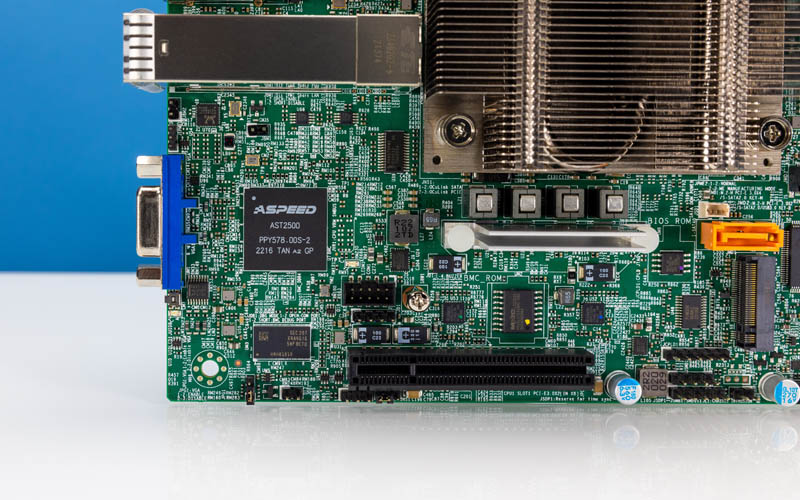
That means we get an updated Supermicro IPMI management interface (and Redfish API) solution versus what we saw on the X10SDV or X11SDV platforms.
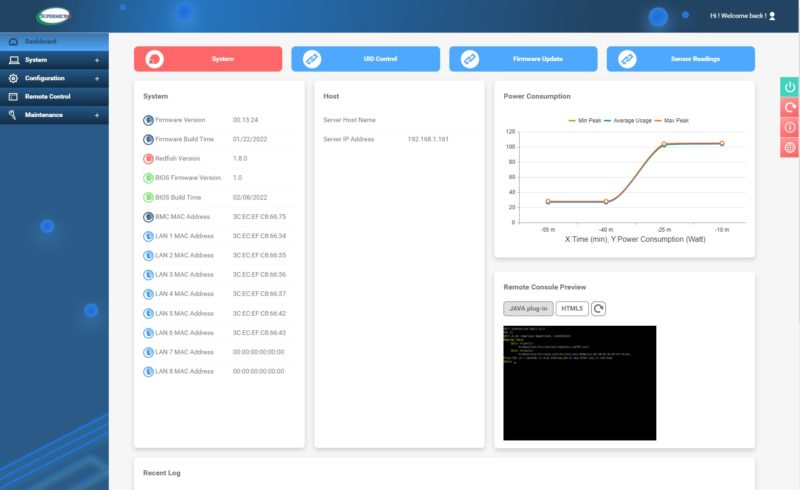
That includes features like HTML5 iKVM functionality included.
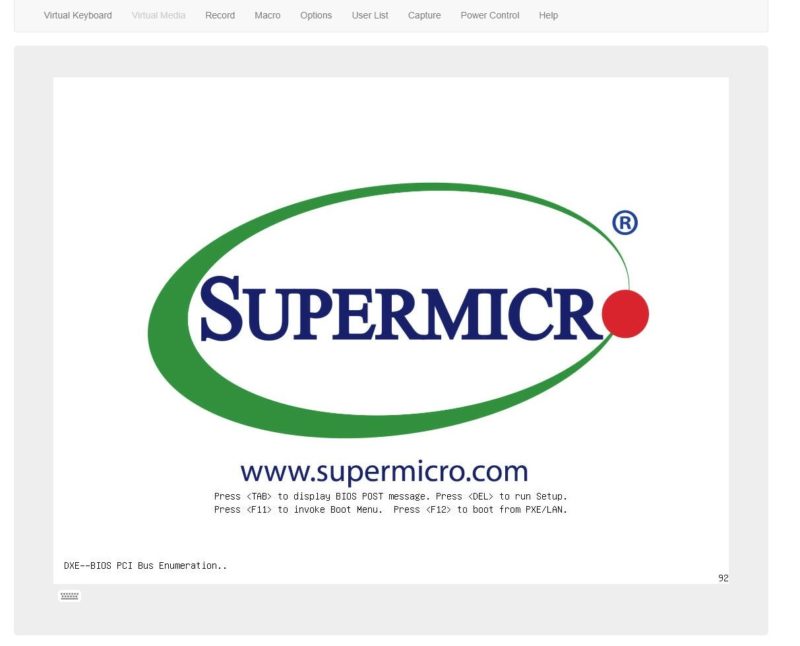
One change that we highlighted recently is that with the HTML5 iKVM, one now needs a license to remote mount media directly when using this solution. We discuss other ways to mount media in the new era of Supermicro management in How to Add Virtual Media to a Supermicro Server via HTML5 iKVM Web IPMI Interface.
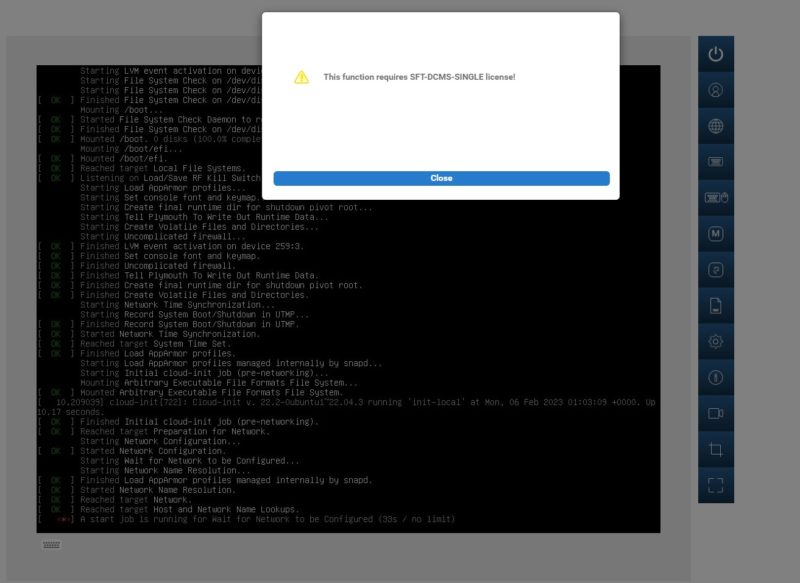
Aside from what is on the motherboard, Supermicro has a number of other tools to help manage its platforms.
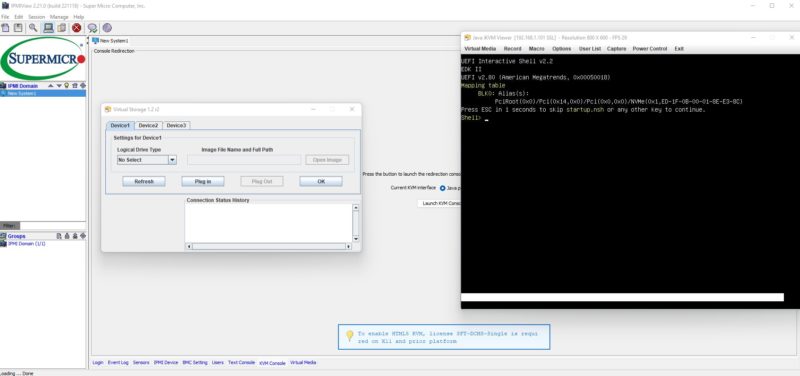
If you recall the photo with the unique BMC password sticker, this is mandated due to new laws that went into effect a few years ago.
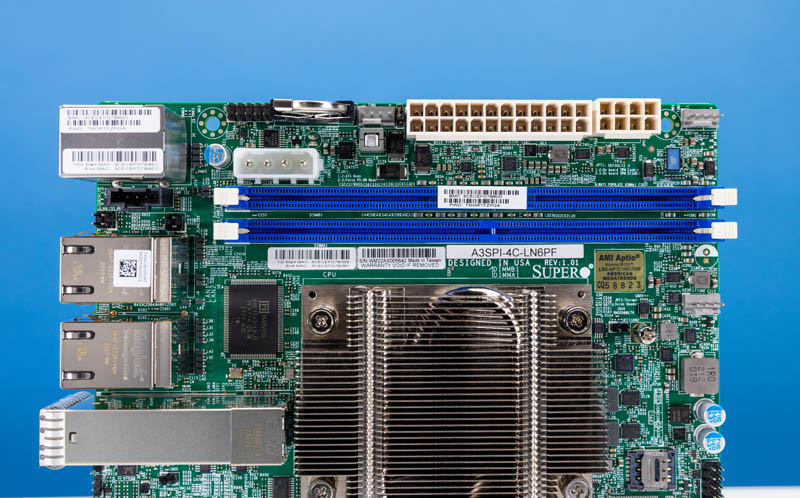
You can learn more about why this is required so the old ADMIN/ ADMIN credentials will not work in Why Your Favorite Default Passwords Are Changing.
Next, let us get to the performance.
Intel Atom C5315 Performance
The performance of the Intel Atom C5315 is not exactly what we expected. What we did expect was that there were going to be instructions like AVX-512 not included. What we did not expect was the impact of the cache structure compared to the Intel N5105/ N6005 chips we tested. One may assume with the larger caches, the performance would be much better, but this is still a four-core Atom.
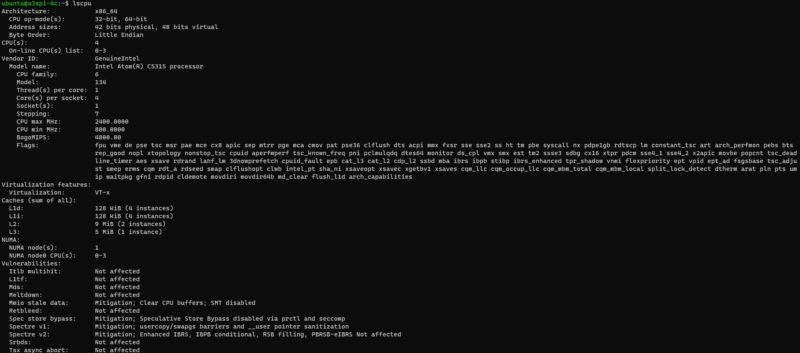
As a result, we wanted to at least test these quickly to see what the performance differences were.
Python Linux 4.4.2 Kernel Compile Benchmark
This is one of the most requested benchmarks for STH over the past few years. The task was simple, we have a standard configuration file, the Linux 4.4.2 kernel from kernel.org, and make the standard auto-generated configuration utilizing every thread in the system. We are expressing results in terms of compiles per hour to make the results easier to read:
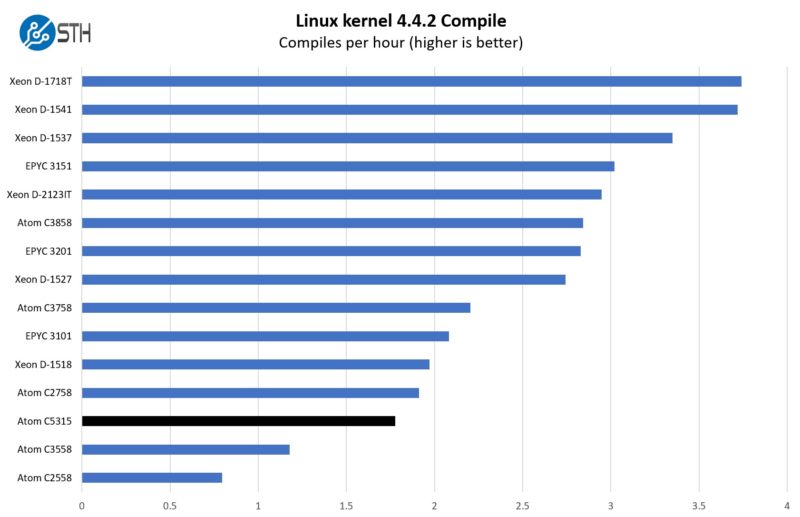
Looking back through generations, we can see that we are nearing around 2x the per-core performance of the Atom C2000 series and a fairly sizable ~30% increase generation on generation versus the C3000 series Atom parts. Even with the large caches, we are nowhere near the Intel Xeon D-1718T. There is a much larger gap here than we saw in some previous generations between lower-end Xeon D and Atom parts.
7-zip Compression Performance
7-zip is a widely used compression/ decompression program that works cross-platform. We started using the program during our early days with Windows testing. It is now part of Linux-Bench.
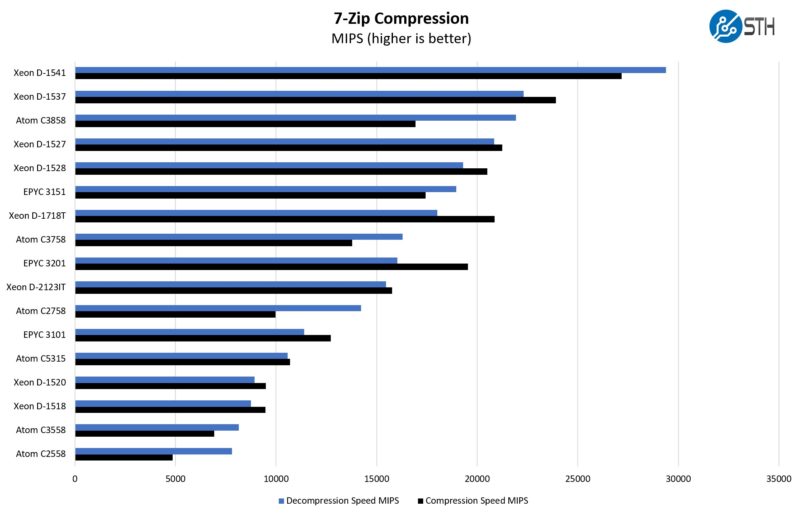
This is a super-cool result. While some may use QAT offload for compression, the non-QAT numbers show something really interesting. We are getting better performance than we get on the older Broadwell-DE 4 core/ 8 thread Intel Xeon D-1520/D-1518 parts and compression faster than 8-core C2758 parts. For older embedded gear, that is a very powerful result since it may mean being able to change to an Atom architecture or using half as many Atom cores for a similar amount of work.
OpenSSL Performance
OpenSSL is widely used to secure communications between servers. This is an important protocol in many server stacks. We first look at our sign tests:
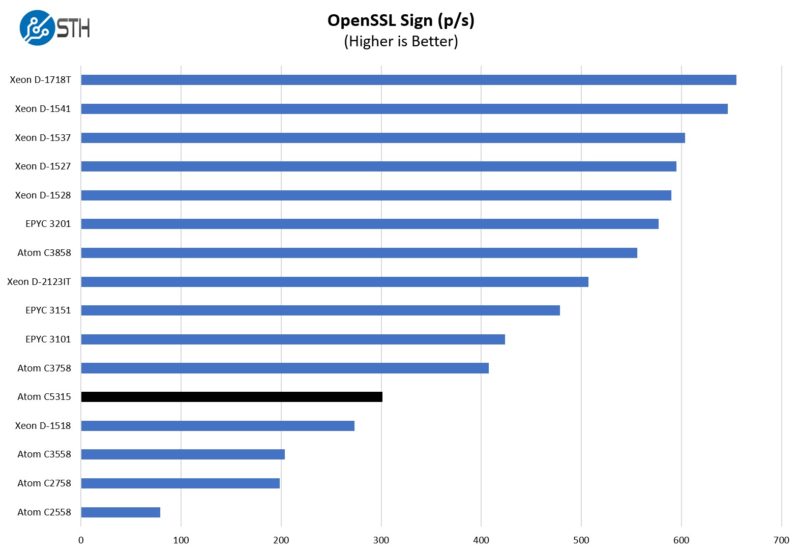
Here are the verify results.
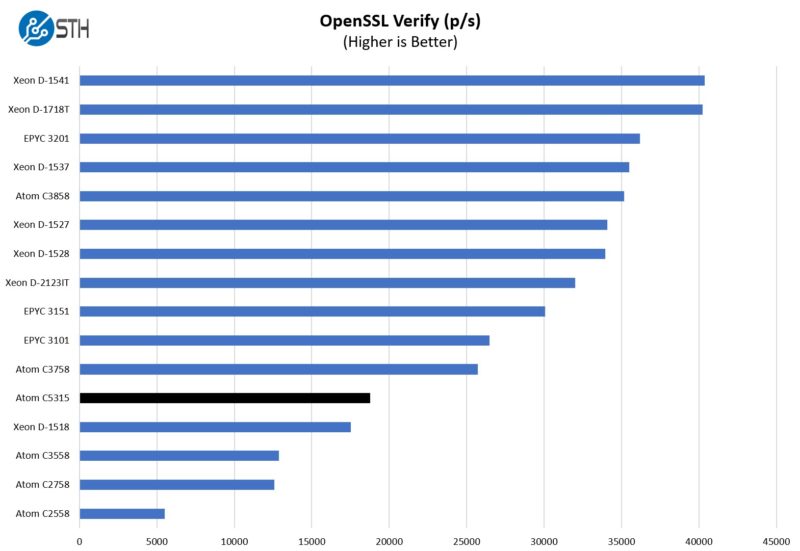
On platforms using the Atom C5315, many are likely to use the crypto offload of QAT. Still, we wanted to see the performance of OpenSSL without the accelerator here to compare it to a broad range of chips. Here we can see the part outpacing the Intel Xeon D-1518 and the Atom C3558 by solid margins.
NAMD Performance
Bringing this back a bit, we wanted to see what would happen with NAMD if we did not use AVX2/ AVX-512 to get more of a base compute performance view.
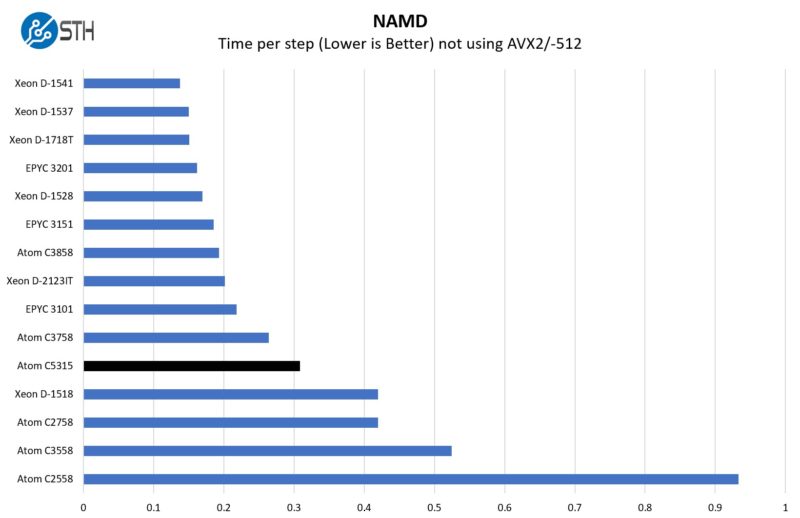
Here, the Intel Atom C5315 is benefitting from not having AVX2 nor AVX-512 enabled. Even without the AVX-512 being used, the Intel Xeon D-1718T is now considerably faster than this generation’s Atom at 4 cores.
Legacy Unixbench dhrystone 2 and whetstone Performance
These are not benchmarks that we have used in a long time, but we recreated our old setup for the Atom C2558 era, and so we could compare data between three generations and a decade of 4-core embedded Atoms. Here are the dhrystone 2 results:
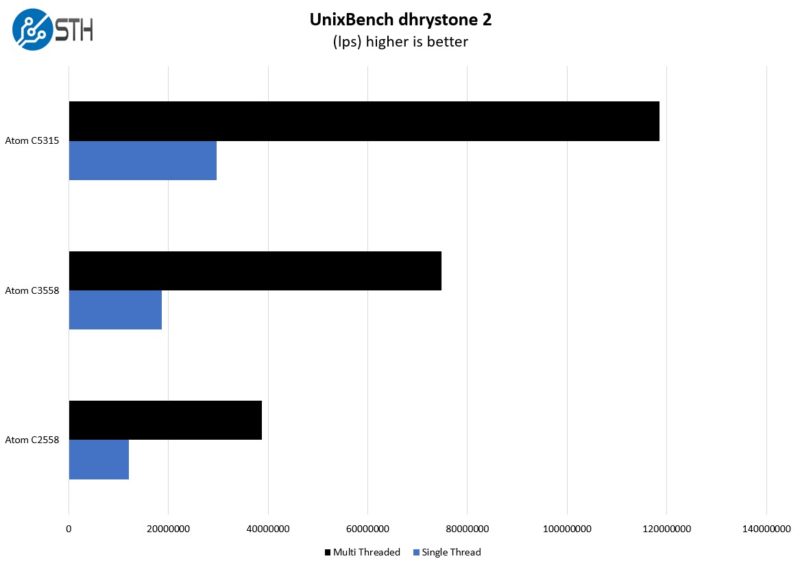
Here are the whetstone results:
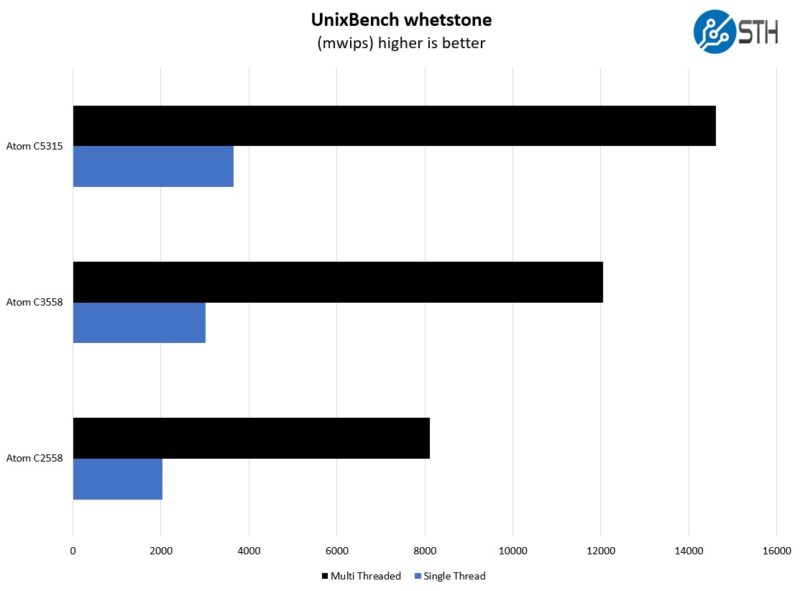
This is certainly far from the most useful benchmark, but we had the data so we just wanted to show it. Even though we still have four cores at 2.4GHz, those four cores are quite a bit faster.
Check Your Own System with Geekbench 5 and Geekbench 6 Results
Since we had this system online over the past few weeks when we were testing Geekbench 6 before that software launched earlier this week. We ran the new Geekbench 6 on the Intel Atom C5315 and the older Geekbench 5 as well. Feel free to use these results linked to compared to other platforms in the database or that you have.
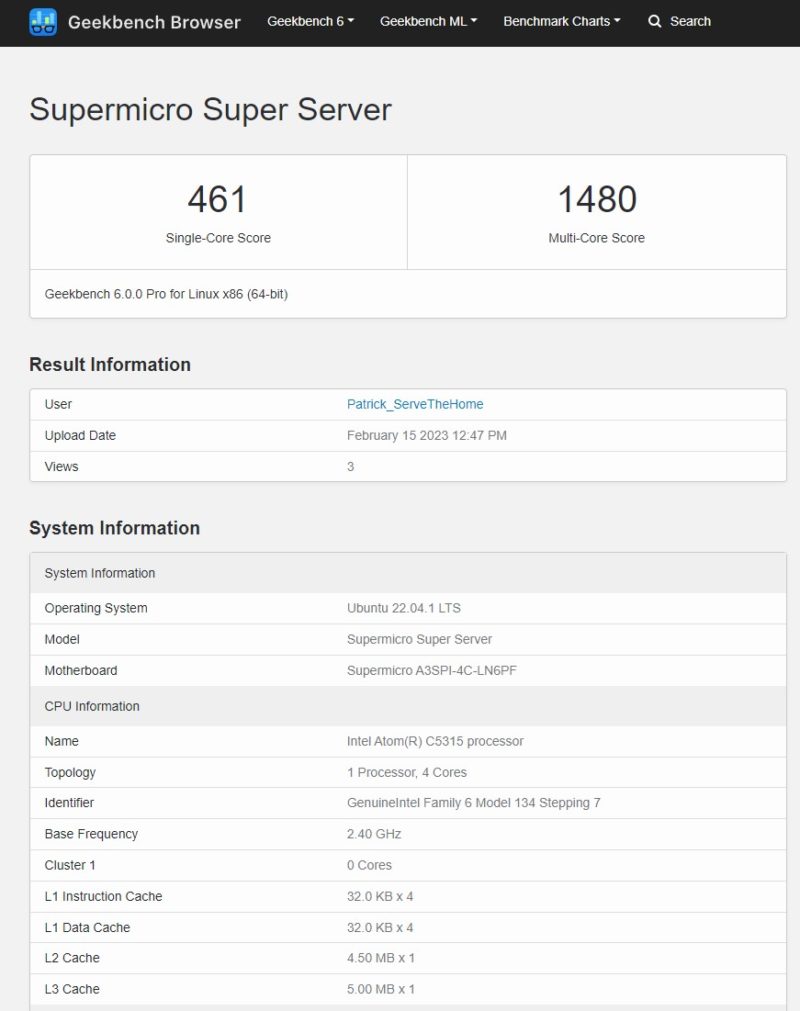
Here, we can see a very close result to the Intel Celeron N5105 v Atom C5315 in our Geekbench 5 runs as well.
Overall, performance is certainly better than the previous generation Intel Atom C3558, but at the end of the day, this is still only a four-core CPU.




That it is still being beat by the Epyc 3101, a 4 core, cpu without smt from 2018 that has a lower power consumption is less than encouraging. Unless Supermicro puts up their first born as a guarantee of the sfp+ abilities, nothing in my past experience with that company would ever bring me to think that this was anything other than a screw up on their end that will be removed either by hardware change or bios lock/neglect.
I’ve been waiting for an updated variant of A2SDI-H-TF for 6 years now. Cheap (~500€), low power (25W), 12sata, 10gbit board and I fear this still wont be it. I won’t be cheap, nor is it low power, and with reduced lanes probably not gonna have a 12sata or its gonna be even higher priced and power hungry model.
@Dami you are essentially right.
Higher TDP, basically 1 NVMe and 1 Sata port (where are all the other lines used for storage went?), and a not-so-exiting networking part.
And benchmarks on all but SSL are basically worse than a C2758, the C2000-era flagship.
I see no real use case for a box like this.
Assuming that the SFP cages are in fact 10GbE this one looks like a competent implementation of the SoC it has to work with(though I’m a little surprised that they allocated 4x lanes to the m.2 and left the PCIe slot with only 2, given that network appliance scenarios don’t tend to lean desperately hard on local storage; and you’d need to be running a pretty decent SSD and a pretty heavy OS for 2-lane NVMe to make boot times or logging unacceptably slow); I’m just wondering what Intel thinks they are playing at.
$120 more than the prior gen part, plus substantially more power hungry; plus less PCIe; for what appear to be pretty marginal generational improvements?
I can understand the premium that network-included Atoms carry vs. the ones that show up in very low end client systems and cheap ‘n cheerful pfsense boxes; even if you don’t care about ECC you won’t actually save much if need to add anything faster than 1-2.5GbE as discrete parts; but $120 is the premium vs. the last gen version of the more or less identically placed part.
I can’t tell if Intel is surprisingly unconcerned by ARM network oriented processors; or if they are really concerned and figure that they might as well extract what they can on the way out of this niche. Over in Xeon-D land there’s still a pretty solid per-thread performance case to be made; but a 4 core fairly high TDP Atom part isn’t in Xeon-D land.
This is a surprisingly weak improvement for near 6 years.
I was looking for a reasonable amount more at the same tdp or of course, significantly more at a higher one.
I do wish AMD would compete in this space , including the platform and board variety, not just processor performance.
After the Intel Avoton fiasco, there’s no way I’m considering the stuff when there are other options.
We were looking forward to this platform but the underwhelming CPU upgrade from the C3000 series and disappointingly large price increase has us looking elsewhere.
Any throughput testing, even just a basic iperf, to see if those 10GbE rates are the real thing, and not just a configuration hiccup somewhere? The thing is certainly confused enough about itself, I wouldn’t be surprised by anything at this point.
The SoC is trimmed down Snow Ridge, which is not very fresh but still very interesting for a number of use cases. These SKUs are a bit old but good if priced correctly (room for 2/3 NVMe SSDs, up to 12 SATA ports, QAT, 10Gbit networking), what really sucks here is Supermicro: they have never managed to get the Atom line right, with the correct offering and ports. Can you explain to me why you must loose 2 PCIe lanes for a B-key M.2 slot on a system with 20Gbit ethernet? WHY? Why a 2 lanes PCIe expansion slot? This way they are both useless! Do you want a small scale NVMe NAS? You can’t now with a C5315. Do you want more than 5 Sata ports? You can’t although the SoC supports them! It’s nonsense, why is Supermicro run by this guys? They try to satisfy multiple scenarios with one product failing badly for all of them.
@Safari
“Can you explain to me why you must loose 2 PCIe lanes for a B-key M.2 slot on a system with 20Gbit ethernet?”
This was actually the reason I bought this board (A3SPI-8C-LN6PF), because you can use it for a 5G cellular modem as a backup link (hence the SIM card slot).
At least that was my intention. Apparently there is a bug in the firmware that does not detect a PCIe cellular modem in the M.2 slot. This issue has been open for 2 months and has been escalated to Intel with no fix or workaround available yet.
@elk Because buying this board/SoC for such a purpose makes no sense. It does makes sense to use it for storage, but you must not waste the few precious PCIe lanes with nonsense slots.